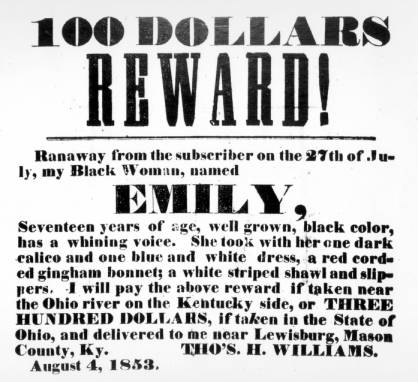In 1855, Ohio was a free state, but the United States still condoned slavery just across the Ohio River. To deal with these conflicting laws across state borders, the federal government passed a series of legislation known as the Fugitive Slave Laws. These laws stated that a Southern slaveholder must not be stopped when returning a captured runaway to the slave system, even in a free state.[1] A true escape could only lie outside the borders of the United States.

However, by April of 1855, a young woman by the name of Rosetta Armstead gained her freedom and tested the operations of this law.
In March of 1855, Rosetta found herself traveling to Virginia with Dr. Miller, a friend of her master Mr. Dennison, who had stayed behind in Kentucky. Due to winter ice still running in the Ohio River, Miller had to map a very circuitous route from Kentucky to Virginia. The travelers were bound to the train schedules, and thus ended up staying a night in Columbus.
As Miller found a hotel room in which to stay, word of Rosetta’s presence spread quickly amongst the African American community in Columbus. Reverend William B. Ferguson rushed to the Probate Court where he made a plea for Armstead’s freedom by Ohio law. A sheriff arrived at midnight that evening to retrieve Rosetta, and soon she was under the guardianship of L.G. Van Slyke.[2]
As the Ohio State Journal reported, “the law had its way and all was quiet.[3]” Rosetta was deemed to be free, and began her life in Columbus.
Unfortunately, Rosetta’s journey had not ended. While visiting with a friend named Dr. Coulter, Rosetta was literally dragged away on a carriage by two slave catchers. Dr. Coulter raised an alarm, and Rosetta’s supporters rushed to the train station where the slave catchers “showed, by presentation of revolvers, that they were determined to take her with them.[4]” Mr. Van Slyke hurried to Cincinnati and telegraphed friends in the city to meet Rosetta upon her arrival.
While awaiting trial, Rosetta moved in and out of Cincinnati jails. Finally she was tried before U.S. Commissioner John L. Pendry with Salmon P. Chase and future president Rutherford B. Hayes as her legal counsel. Here the decision was made that Rosetta could not be held to the Fugitive Slave Law, because she had not escaped. An agent of her master had brought her into free territory willingly. L.G. Van Slyke even claimed that Mr. Dennison came to his house and told Rosetta she could remain free if she desired. Rosetta indeed desired her freedom, and by the end of April, the court declared Rosetta Armstead was a free woman.
Not everyone was happy with the decision to free Rosetta. Citizens of Mr. Dennison’s home state of Kentucky argued and fought every detail of the case with anti-slavery groups in Ohio, often through newspaper editorials. Dennison himself echoed many of his fellow Kentuckians when he wrote to the Ohio Statesman saying, “…personal rights are dearer to the people of the South than the barren glory derived from a union with strangers…[6]” This issue of personal and states’ rights was tied up in many issues- including slavery. Thoughts like Dennison’s helped spur on the Civil War just a few years later.
